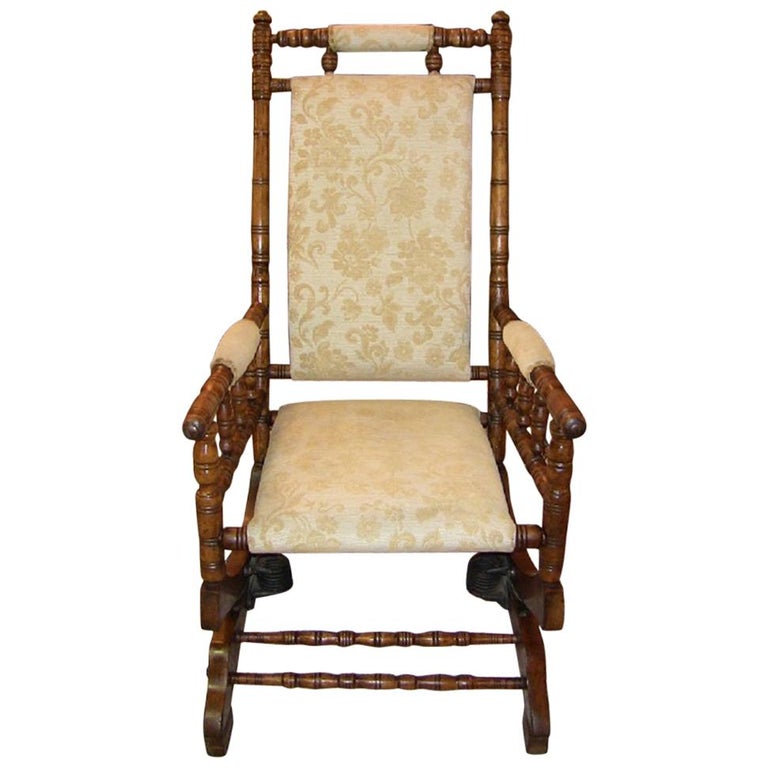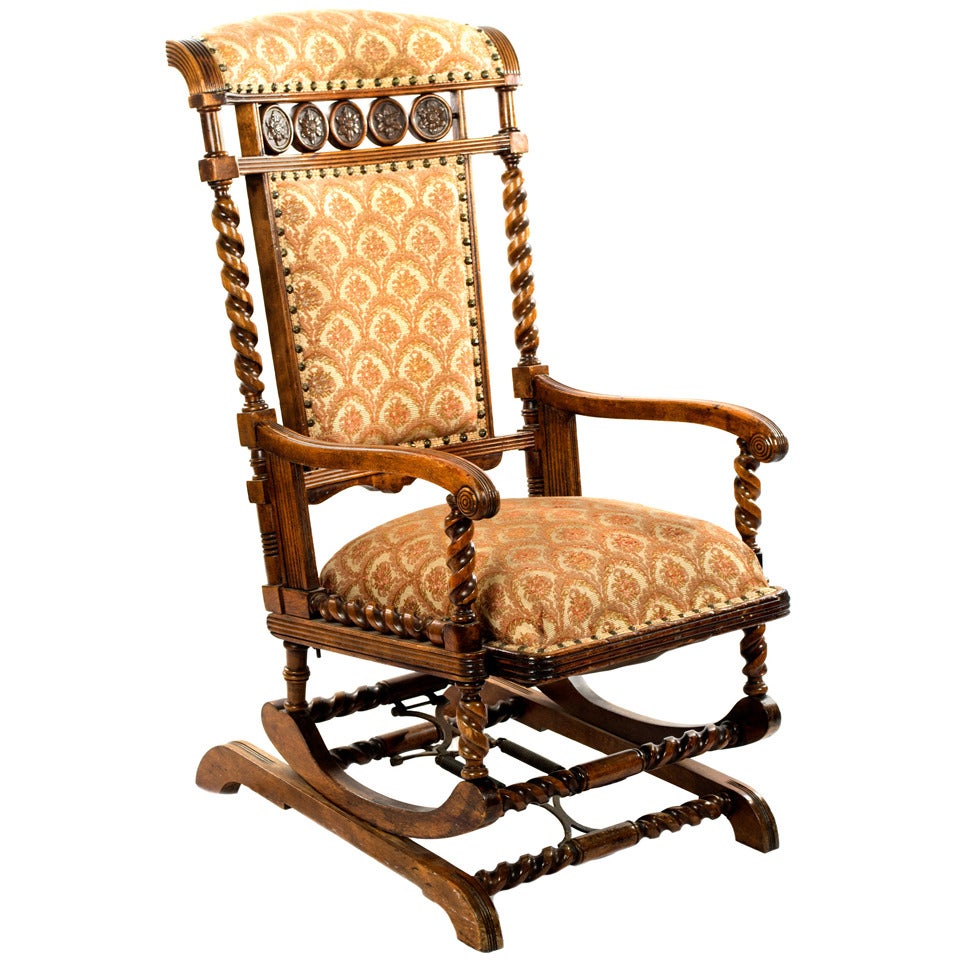The Hunzinger Rocking Chair

The Hunzinger Rocking Chair, a timeless piece of furniture, holds a significant place in American history and design. Its origins, design, and enduring popularity tell a story of craftsmanship, innovation, and the evolving tastes of a nation.
The Chair’s Origins and Designer, Hunzinger rocking chair 1869
The Hunzinger Rocking Chair was designed and crafted by Jacob Hunzinger, a skilled cabinetmaker who immigrated from Germany to the United States in the mid-19th century. Hunzinger established his workshop in the bustling city of Cincinnati, Ohio, a hub for furniture production at the time. He was known for his meticulous craftsmanship and his ability to create elegant and functional pieces.
The Social and Cultural Context of the Chair’s Creation
The year 1869, when the Hunzinger Rocking Chair was introduced, was a pivotal period in American history. The nation was recovering from the Civil War, and a sense of optimism and prosperity was emerging. The Victorian era, with its emphasis on domesticity and refined taste, was in full swing. This era saw a surge in the popularity of rocking chairs, which were seen as symbols of comfort, relaxation, and family life.
Comparison to Other Rocking Chair Designs of the Era
The Hunzinger Rocking Chair stood out among other rocking chair designs of the era for its distinctive features. Unlike the simpler, more utilitarian rocking chairs that were common at the time, the Hunzinger chair incorporated elaborate carvings, intricate joinery, and a graceful, flowing form. This combination of elegance and functionality made it a popular choice among affluent families.
Anecdotes and Stories Related to the Chair’s Early Years
One interesting anecdote about the Hunzinger Rocking Chair involves a prominent Cincinnati family who commissioned a custom-made version of the chair. They requested that the chair be crafted from a rare and highly prized wood, and they specified that the carvings should depict scenes from their family history. This detail highlights the chair’s status as a symbol of both comfort and personal significance.
Design and Construction of the Hunzinger Rocking Chair: Hunzinger Rocking Chair 1869

The Hunzinger Rocking Chair, crafted in 1869, stands as a testament to the ingenuity and craftsmanship of its time. Its unique design features, materials, and construction techniques all contribute to its enduring comfort and functionality.
Materials and Construction
The chair’s construction reveals a meticulous attention to detail and a commitment to quality. The Hunzinger Rocking Chair is primarily constructed from solid American black walnut, a hardwood known for its strength, durability, and rich color.
- The chair’s frame is crafted from carefully selected black walnut planks, ensuring a robust and stable foundation.
- The chair’s rockers are also made from black walnut, meticulously shaped and joined to provide a smooth and comfortable rocking motion.
- The chair’s seat is upholstered with leather, adding a touch of luxury and durability. The leather is carefully stretched and secured to the frame using hand-driven tacks.
- The chair’s back is also upholstered with leather, providing support and comfort. The leather is carefully shaped and stitched to create a flowing and elegant design.
The chair’s construction is a testament to the skilled craftsmanship of the era. The chair’s joints are meticulously crafted using traditional mortise and tenon techniques, ensuring a strong and durable construction. The chair’s finish is also expertly applied, enhancing the natural beauty of the wood and protecting it from wear and tear.
Design Features
The Hunzinger Rocking Chair’s design incorporates a number of features that contribute to its comfort and functionality.
- The chair’s curved back provides excellent lumbar support, allowing the user to relax and recline comfortably.
- The chair’s wide seat provides ample room for the user to sit comfortably.
- The chair’s rockers are carefully shaped to provide a smooth and comfortable rocking motion. The rockers are designed to provide a gentle and relaxing rocking motion, ideal for reading, relaxing, or simply enjoying the moment.
- The chair’s arms are positioned at a comfortable height, providing support for the user’s arms and elbows.
Aesthetics and Impact
The Hunzinger Rocking Chair is not only comfortable and functional but also aesthetically pleasing. Its simple yet elegant design, crafted from high-quality materials, reflects the design trends of the late 19th century. The chair’s smooth lines, flowing curves, and rich wood finish create a sense of refinement and sophistication.
The Hunzinger Rocking Chair exemplifies the craftsmanship and design aesthetic of the Victorian era. Its enduring popularity speaks to its timeless appeal and its ability to seamlessly blend into various interior design styles.
Materials Table
| Material | Origin | Properties |
|---|---|---|
| American Black Walnut | Eastern United States | Strong, durable, rich color, beautiful grain pattern |
| Leather | Various origins | Durable, comfortable, adds a touch of luxury |
| Brass Tacks | Various origins | Durable, decorative, used for securing upholstery |
The Hunzinger Rocking Chair in Contemporary Culture

The Hunzinger rocking chair, a testament to 19th-century craftsmanship, continues to hold a special place in contemporary culture, transcending its historical significance to become a symbol of comfort, tradition, and enduring design. Its legacy extends beyond its physical presence, influencing modern furniture design and captivating the imagination in various forms of art and literature.
The Hunzinger Rocking Chair’s Influence on Modern Furniture Design
The Hunzinger rocking chair’s design principles, emphasizing simplicity, functionality, and elegant curves, have inspired numerous modern furniture designers. Its sturdy construction, often crafted from durable hardwoods, and its timeless appeal have influenced contemporary interpretations of rocking chairs, incorporating modern materials and innovative techniques while retaining the essence of the original design. The Hunzinger rocking chair’s influence can be observed in the minimalist rocking chairs of contemporary furniture designers, who strive to create pieces that are both aesthetically pleasing and comfortable, reflecting the principles of simplicity and functionality embodied in the Hunzinger design.
Examples of the Hunzinger Rocking Chair in Popular Culture
The Hunzinger rocking chair’s enduring appeal has made it a recurring motif in popular culture, appearing in various forms of art, literature, and film. In literature, the rocking chair often symbolizes comfort, nostalgia, and a connection to the past. For instance, in the novel “To Kill a Mockingbird” by Harper Lee, Atticus Finch, the protagonist, sits in a rocking chair on the porch of his home, reflecting on the events of the story. The rocking chair in this context represents a sense of peace and contemplation, highlighting the character’s moral compass and his connection to the community.
Stories of Individuals Who Own or Have Owned a Hunzinger Rocking Chair
Many individuals who own or have owned a Hunzinger rocking chair cherish the experience of owning a piece of history. The chair’s craftsmanship, its enduring comfort, and its unique character create a special connection between the owner and the object. Stories abound of individuals who have inherited a Hunzinger rocking chair from a grandparent or great-grandparent, passing down the chair through generations, each owner adding their own memories and experiences to its history. These individuals often describe the chair as a source of comfort, a place to relax and reflect, and a tangible link to the past.
A Hypothetical Scenario Where the Hunzinger Rocking Chair Plays a Significant Role
In a contemporary narrative set in a small town, a young artist inherits a Hunzinger rocking chair from her grandmother. The chair, a relic of her family’s past, becomes a source of inspiration for her art. As she sits in the chair, reflecting on her grandmother’s life and her own creative journey, she finds herself drawn to the chair’s simple elegance and its connection to the past. The chair becomes a symbol of her artistic heritage, a reminder of the enduring power of creativity and the importance of preserving family traditions. The artist incorporates the rocking chair’s design into her artwork, creating a series of paintings that celebrate the chair’s beauty and its enduring legacy.
Hunzinger rocking chair 1869 – So you want a Hunzinger rocking chair from 1869? Good luck finding one that isn’t a museum piece! Unless you’re handy with a saw and some sandpaper, you might want to consider a more modern approach. Check out these diy pallet rocking chair plans , they’ll have you rocking in style (and on a budget) in no time.
Just don’t expect your pallet creation to be worth as much as a vintage Hunzinger, though. Those things are practically gold!
You’re telling me a Hunzinger rocking chair from 1869 can still rock? That’s some serious craftsmanship! I bet it’s seen more generations than a grey baby rocking chair has seen sippy cups. But hey, if it’s still going strong, that Hunzinger must be a real survivor!
